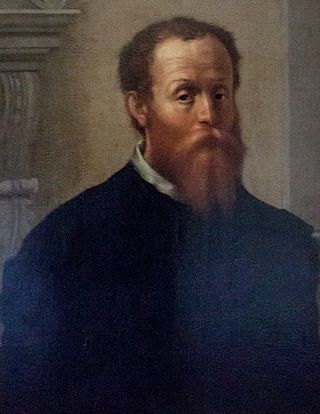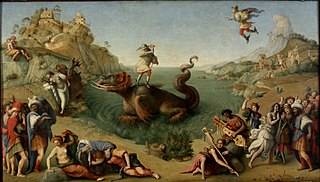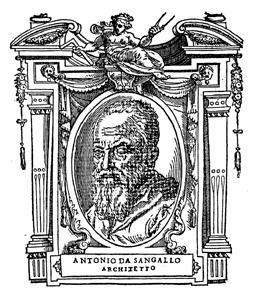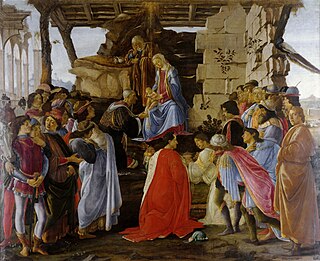
The House of Medici was an Italian banking family and political dynasty that first consolidated power in the Republic of Florence under Cosimo de' Medici during the first half of the 15th century. The family originated in the Mugello region of Tuscany, and prospered gradually until it was able to fund the Medici Bank. This bank was the largest in Europe during the 15th century and facilitated the Medicis' rise to political power in Florence, although they officially remained citizens rather than monarchs until the 16th century.

Baccio Bandinelli, was an Italian Renaissance sculptor, draughtsman, and painter.

Piero della Francesca was an Italian painter, mathematician and geometer of the Early Renaissance, nowadays chiefly appreciated for his art. His painting is characterized by its serene humanism, its use of geometric forms and perspective. His most famous work is the cycle of frescoes The History of the True Cross in the church of San Francesco in the Tuscan town of Arezzo.

Andrea del Verrocchio was an Italian sculptor, painter and goldsmith who was a master of an important workshop in Florence.

Piero di Cosimo, also known as Piero di Lorenzo, was an Italian Renaissance painter, who continued to use an essentially Early Renaissance style into the 16th century.

Giuliano da Sangallo was an Italian sculptor, architect and military engineer active during the Italian Renaissance. He is known primarily for being the favored architect of Lorenzo de' Medici, his patron. In this role, Giuliano designed a villa for Lorenzo as well as a monastery for Augustinians and a church where a miracle was said to have taken place. Additionally, Giuliano was commissioned to build multiple structures for Pope Julius II and Pope Leo X. Leon Battista Alberti and Filippo Brunelleschi heavily influenced Sangallo and in turn, he influenced other important Renaissance figures such as Raphael, Leonardo da Vinci, his brother Antonio da Sangallo the Elder, and his sons, Antonio da Sangallo the Younger and Francesco da Sangallo.

Antonio da Sangallo the Elder was an Italian Renaissance architect who specialized in the design of fortifications.

Antonio da Sangallo the Younger, also known as Antonio Cordiani, was an Italian architect active during the Renaissance, mainly in Rome and the Papal States. One of his most popular projects that he worked on designing is St. Peter’s basilica in the Vatican City. He was also an engineer who worked on restoring several buildings. His success was greatly due to his contracts with renowned artists during his time. Sangallo died in Terni, Italy, and was buried in St. Peter’s Basilica.

Francesco da Sangallo (1494–1576) was an Italian Renaissance sculptor, the son of the architect and sculptor Giuliano da Sangallo.

Bastiano da Sangallo was an Italian sculptor, painter and architect of the Renaissance period, active mainly in Tuscany. He was a nephew of Giuliano da Sangallo and Antonio da Sangallo the Elder. He is usually known as Aristotile, a nickname he received from his air of sententious gravity. He was at first a pupil of Perugino, but afterwards became a follower of Michelangelo. Sangallo was mentioned by Vasari as one who made a small copy of the Cartoon of Michelangelo's Battle of Cascina (1506).

The Sassetti Chapel is a chapel in the basilica of Santa Trinita in Florence, Italy. It is especially notable for its frescoes of the Stories of St. Francis, considered Domenico Ghirlandaio's masterwork.
The decade of the 1480s in art involved some significant events.

The Adoration of the Magi is a painting by the Italian Renaissance master Sandro Botticelli. Botticelli painted this piece for the altar in Gaspare di Zanobi del Lama's chapel in Santa Maria Novella around 1475. This painting depicts the Biblical story of the Three Magi following a star to find the newborn Jesus. The image of the altarpiece centers on the Virgin Mary and the newborn Jesus, with Saint Joseph behind them. Before them are the three kings who are described in the New Testament story of the Adoration of the Magi. The three kings worship the Christ Child and present him with gifts of gold, frankincense and myrrh. In addition, the Holy Family is surrounded by a group of people who came to see the child who was said to be the son of God.

The Magi Chapel is a chapel in the Palazzo Medici Riccardi of Florence, Italy. Its walls are almost entirely covered by a famous cycle of frescoes by the Renaissance master Benozzo Gozzoli, painted around 1459 for the Medici family, the effective rulers of Florence.

The Lives of the Most Excellent Painters, Sculptors, and Architects, often simply known as The Lives, is a series of artist biographies written by 16th-century Italian painter and architect Giorgio Vasari, which is considered "perhaps the most famous, and even today the most-read work of the older literature of art", "some of the Italian Renaissance's most influential writing on art", and "the first important book on art history".

Bernardo Rucellai, also known as Bernardo di Giovanni Rucellai or Latinised as Bernardus Oricellarius, was a member of the Florentine political and social elite. He was the son of Giovanni di Paolo Rucellai (1403–1481) and father of Giovanni di Bernardo Rucellai (1475–1525). He was married to Nannina de' Medici, the elder sister of Lorenzo de' Medici, and was thus uncle to Popes Leo X and Clement VII, who were cousins. Oligarch, banker, ambassador and man of letters, he is today remembered principally for the meetings of the members of the Accademia Platonica in the Orti Oricellari, the gardens of his house in Florence, the Palazzo Rucellai, where Niccolò Machiavelli gave readings of his Discorsi.

Francesco di Antonio del Chierico (1433–1484) was a manuscript illuminator of the early Renaissance period in Florence. Francesco began as a goldsmith before changing occupations to become a successful illustrator. He was one of the pupils of Fra Angelico and became famous for being Lorenzo de' Medici's favorite illuminator. He worked under some of the most prestigious patrons of the time, including Lorenzo de' Medici, Piero de’ Cosimo de' Medici, Cosimo il Vecchio, and Vespasiano da Bisticci. He gained a reputation for his well executed illustrations in varying types of books ranging in size from small books of hours to large choir books. His illustrations often included intricate floral arrangements, putti, and candelabras. He decorated both the borders of manuscripts and full pages.

The Medici Villa of Poggio a Caiano, also called Ambra, is one of the most famous Medici villas and is located in Poggio a Caiano (Prato). Today it is state owned and it houses two museums: one of the historic apartments and the Museum of Still Life.

An anonymous author known as the Anonimo Gaddiano, Anonimo Magliabechiano, or Anonimo Fiorentino is the author of the Codice Magliabechiano or Magliabechiano, a manuscript with 128 pages of text, probably from the 1530s and 1540s, and now in the Central National Library of Florence. It includes brief biographies and notes on the works of Italian artists, mainly those active in Florence during the Middle Ages. Among several other suggestions, the anonymous author has been suggested to be Bernardo Vecchietti (1514–1590), a politician of the court of Cosimo I. The author clearly had intimate access to the Medici court.



















